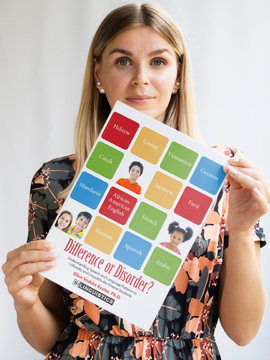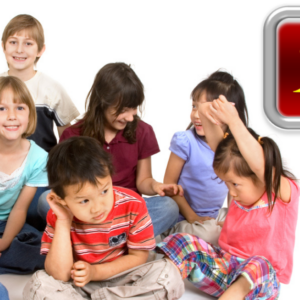Academic Vocabulary Intervention for Bilingual Children with Language Disorders
$22.00

90 MINUTES (0.15 ASHA CEUs)
Course Type: Video – 1 1/2 hours
ASHA Course Code: Diversity Equity and Inclusion – 7030
When bilingual children present with Developmental Language Disorders, finding language intervention materials that work well is tricky because they need to take into account aspects of both languages, a child’s age and experience, and progress in the classroom. The good news is that materials exist that meet these challenges head-on.
Join Dr. Celeste Roseberry-McKibbin as she reviews available materials to effectively teach academic vocabulary, including practical recommendations for using these materials to support academic success for these students.
Additional Information
| Population | School Age |
|---|---|
| Duration | 1.5 hours |
| Credit | .15 Continuing Education Units |
| Topics | Diversity, Equity, & Inclusion (DEI), Exp/Rec Language |
| Format | Video |
Celeste Roseberry-McKibbin received her Ph.D. from Northwestern University. She is a Professor of Communication Sciences and Disorders at California State University, Sacramento. Dr. Roseberry-McKibbin is also currently a part-time itinerant SLP in San Juan Unified School District where she provides direct services to students ages 3-18. She has worked in educational and medical settings with a wide variety of clients ranging from preschoolers through geriatric patients. Dr. Roseberry McKibbin’s primary research interests are in the areas of assessment and treatment of culturally and linguistically diverse students with communication disorders as well as service delivery to students from low-income backgrounds. She has over 70 publications, including 17 books, and has made over 700 presentations at the local, state, national, and international levels. Dr. Roseberry is a Fellow of ASHA, and winner of ASHA’s Certificate of Recognition for Special Contributions in Multicultural Affairs. She has received ASHA’s Honors of the Association. She received the national presidential Daily Point of Light Award for her volunteer work in building literacy skills of children experiencing poverty. She lived in the Philippines as the daughter of Baptist missionaries from ages 6 to 17.
Financial: Dr. Roseberry received payment for this presentation.
Non-financial – No relevant nonfinancial relationship exists
There are increasing numbers of English Learners (ELs) in American classrooms today. Some of them have Developmental Language Disorder (DLD) and receive intervention in the school setting. It is ideal to provide intervention that supports bilingual development in both the first language (L1) and English. When providing therapy, speech-language pathologists (SLPs) can most benefit ELs with DLD by connecting therapy to the curriculum of the classroom, particularly focusing on Tier 2 academic classroom vocabulary. This seminar provides a scientifically based description of how to most effectively teach English academic vocabulary to ELs with DLD, concluding with practical recommendations for methods and materials that can be used to support academic success for these students.
The numbers of school-aged English Learners (ELs) are increasing across the U.S. The percentage of public-school students in the United States who were ELs was higher in fall 2017 (10.1%) than in fall 2000 (8.1%) (National Center for Education Statistics, 2020). Unfortunately, American schools are not providing adequate support for these students. Even typically developing ELs may struggle academically in school (Fumero & Tibi, 2020). If ELs have Developmental Language Disorder (DLD), it becomes even more challenging for them to access the curriculum of the classroom, especially the English Language Arts (ELA) standards which are part of national curriculum standards.
Research supports intervention in several areas that are critical to building vocabulary skills. These areas include a bilingual approach to intervention, teaching content-area cognates to link L1 (first language) and L2 (second language) learning, facilitating multiple exposures and active engagement during learning, teaching Tier 2 vocabulary words, and strengthening phonological awareness skills.
Much research has emphasized the necessity of bilingual intervention to affect positive changes in the ability of students with DLD to communicate in both the first language and English (Cycyk & Huerta, 2020; Kohnert et al., 2021; & Yeomans-Maldonado, 2021; Rosa-Lugo et al., 2020). Thus, even if SLPs are monolingual English speakers, it is critical to involve families in carryover activities at home that are conducted in the home to promote continued L1 development (Cycyk & Huerta, 2021). Bilingual paraprofessionals and other school personnel who speak students’ first languages may be engaged to facilitate bilingual intervention to improve vocabulary skills in L1 along with English.
Researchers have recommended teaching content-area cognates to support increasing language skills in EL students with DLD (Dam et al., 2020; Squires et al., 2020). For example, many words in Spanish are quite similar to their English counterparts. When teaching geometry to Spanish-speaking students, for example, professionals can use cognates such as angle (ángulo), triangle (triángulo), sphere (esfera), and parallel lines (lineas paralelas).
For EL students with DLD, it is critical to teach vocabulary through multiple exposures to words and active engagement in learning these new words. Developing rich vocabulary skills positively impacts a number of areas (Dam et al., 2020).
In order to incorporate the ELA Standards into vocabulary intervention, experts today agree that “Tier 2” words should be targeted (Moore & Montgomery, 2018; Rosa-Lugo et al., 2020). Tier 2 words are high frequency words that are found across a variety of domains (e.g., measure, evaluate, fortunate, coincidence, similar).
It is important to teach vocabulary words that are critical for following directions and understanding the content of subject matter emphasized within the classroom. For example, students need to understand words such as before, after, and next. Standardized tests of academic achievement often use words such as compare, contrast, define, describe, and enumerate.
Clinicians can also use curriculum materials from the classroom in intervention activities (Roseberry-McKibbin, 2022). For example, as a practicing part time itinerant public-school SLP, the first author sometimes asks students to bring their English language arts books to their therapy sessions. We use the current story they are reading to target Tier 2 vocabulary, reading comprehension, and phonological awareness among other skills.
A vocabulary teaching hierarchy presents a process for teaching Tier 2 vocabulary words to EL students with DLD. This hierarchy addresses cognitive weaknesses in working memory and attention that have been cited in the research (Delage & Frauenfelder, 2020; Guiberson & Rodriguez, 2020; Park et al., 2020;). Cognitive weaknesses in working memory, speed, and attention can be addressed through multiple exposures to and active engagement with the words to promote deeper learning and improved retention.
Second, the hierarchy incorporates phonological awareness activities since there is a strong reciprocal relationship between phonological awareness and vocabulary skills. Third, the hierarchy begins with having EL students with DLD demonstrate receptive vocabulary knowledge before expressive knowledge. In the early stages of learning an L2, some students may go through a “silent period” where they do little-no speaking and focus on comprehension of the L2. Thus, the hierarchy of objectives presented in this seminar starts with receptive learning of new vocabulary that gives verbal space to ELs with DLD and gradually builds into more complex verbal answers as students progress through the hierarchy.
The increasing number of EL students in America’s schools demands that professionals attend to their academic and learning needs. To improve educational outcomes for these students, this seminar will focus on improving academic vocabulary skills for increased curricular access to the ELA standards of national curriculum standards.
Participants will be able to:
• Describe the challenges experienced by ELs with DLD in accessing the curriculum of the classroom
• Explain the need for speech-language pathologists (SLPs) to support both the first language and English in intervention
• Discuss practical materials and strategies for teaching Tier 2 academic vocabulary words to ELs with DLD to increase their access to classroom curriculum
• List a specifically sequenced vocabulary teaching hierarchy that is supported by research to provide culturally responsive intervention
Time-Ordered Agenda
10 minutes—Introduction to the topic
10 minutes—Describing academic challenges experienced by EL students with DLD
10 minutes—Providing research-based evidence for supporting the first language and English in intervention
30 minutes—Discussing practical materials and strategies for teaching Tier 2 academic vocabulary words to ELs with DLD to increase their access to classroom curriculum
15 minutes—Describing a specifically sequenced vocabulary teaching hierarchy that is supported by research to provide culturally responsive intervention
15 minutes—Moderated Q and A
Need CEUs?

 Share
Share
 Tweet
Tweet
 LinkedIn
LinkedIn
 Pin
Pin
 Email
Email







